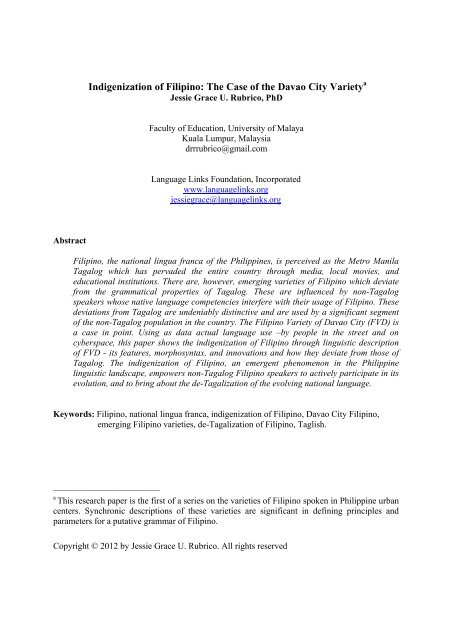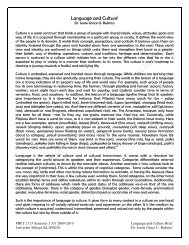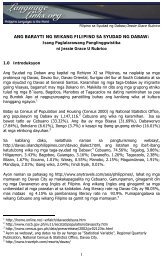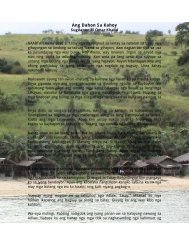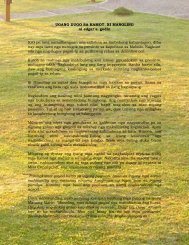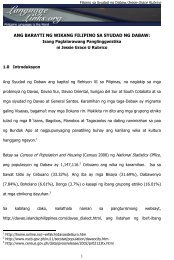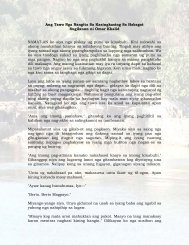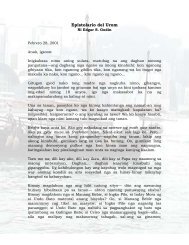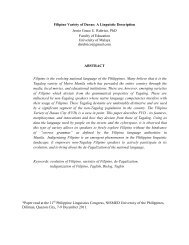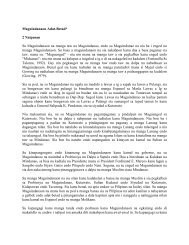Indigenization of Filipino: The Case of the Davao City Variety
Indigenization of Filipino: The Case of the Davao City Variety
Indigenization of Filipino: The Case of the Davao City Variety
You also want an ePaper? Increase the reach of your titles
YUMPU automatically turns print PDFs into web optimized ePapers that Google loves.
<strong>Indigenization</strong> <strong>of</strong> <strong>Filipino</strong>: <strong>The</strong> <strong>Case</strong> <strong>of</strong> <strong>the</strong> <strong>Davao</strong> <strong>City</strong> <strong>Variety</strong> aJessie Grace U. Rubrico, PhDFaculty <strong>of</strong> Education, University <strong>of</strong> MalayaKuala Lumpur, Malaysiadrrrubrico@gmail.comLanguage Links Foundation, Incorporatedwww.languagelinks.orgjessiegrace@languagelinks.orgAbstract<strong>Filipino</strong>, <strong>the</strong> national lingua franca <strong>of</strong> <strong>the</strong> Philippines, is perceived as <strong>the</strong> Metro ManilaTagalog which has pervaded <strong>the</strong> entire country through media, local movies, andeducational institutions. <strong>The</strong>re are, however, emerging varieties <strong>of</strong> <strong>Filipino</strong> which deviatefrom <strong>the</strong> grammatical properties <strong>of</strong> Tagalog. <strong>The</strong>se are influenced by non-Tagalogspeakers whose native language competencies interfere with <strong>the</strong>ir usage <strong>of</strong> <strong>Filipino</strong>. <strong>The</strong>sedeviations from Tagalog are undeniably distinctive and are used by a significant segment<strong>of</strong> <strong>the</strong> non-Tagalog population in <strong>the</strong> country. <strong>The</strong> <strong>Filipino</strong> <strong>Variety</strong> <strong>of</strong> <strong>Davao</strong> <strong>City</strong> (FVD) isa case in point. Using as data actual language use –by people in <strong>the</strong> street and oncyberspace, this paper shows <strong>the</strong> indigenization <strong>of</strong> <strong>Filipino</strong> through linguistic description<strong>of</strong> FVD - its features, morphosyntax, and innovations and how <strong>the</strong>y deviate from those <strong>of</strong>Tagalog. <strong>The</strong> indigenization <strong>of</strong> <strong>Filipino</strong>, an emergent phenomenon in <strong>the</strong> Philippinelinguistic landscape, empowers non-Tagalog <strong>Filipino</strong> speakers to actively participate in itsevolution, and to bring about <strong>the</strong> de-Tagalization <strong>of</strong> <strong>the</strong> evolving national language.Keywords: <strong>Filipino</strong>, national lingua franca, indigenization <strong>of</strong> <strong>Filipino</strong>, <strong>Davao</strong> <strong>City</strong> <strong>Filipino</strong>,emerging <strong>Filipino</strong> varieties, de-Tagalization <strong>of</strong> <strong>Filipino</strong>, Taglish.________________________aThis research paper is <strong>the</strong> first <strong>of</strong> a series on <strong>the</strong> varieties <strong>of</strong> <strong>Filipino</strong> spoken in Philippine urbancenters. Synchronic descriptions <strong>of</strong> <strong>the</strong>se varieties are significant in defining principles andparameters for a putative grammar <strong>of</strong> <strong>Filipino</strong>.Copyright © 2012 by Jessie Grace U. Rubrico. All rights reserved
<strong>Indigenization</strong> <strong>of</strong> <strong>Filipino</strong> : <strong>The</strong> <strong>Case</strong> <strong>of</strong> <strong>the</strong> <strong>Davao</strong> <strong>City</strong> <strong>Variety</strong> (Rubrico 2012)<strong>Filipino</strong> is <strong>the</strong> national lingua franca <strong>of</strong> <strong>the</strong> Philippines. It is Tagalog-based, although ‘Pilipinobased’would be more technically or politically correct. Constitutionally mandated to evolve into<strong>the</strong> country’s national language, its basis for development and enrichment are “existingPhilippine and o<strong>the</strong>r languages.” As it evolves, <strong>Filipino</strong> undergoes modifications by its non-Tagalog speakers to suit <strong>the</strong> grammars <strong>of</strong> <strong>the</strong>ir native languages; thus, <strong>the</strong> birthing <strong>of</strong> emergingvarieties <strong>of</strong> <strong>Filipino</strong> which deviate from <strong>the</strong> grammatical properties <strong>of</strong> Tagalog. Thisphenomenon paves <strong>the</strong> way for its indigenization, <strong>the</strong> process <strong>of</strong> “changing <strong>the</strong> language to suit<strong>the</strong> communicative needs <strong>of</strong> non- native users . . . <strong>the</strong> process through which it is accommodatedand adapted to its speakers and <strong>the</strong>ir circumstances” (Kachru, 1982 cited in Kadenge, 2009,p.156). This paper describes <strong>the</strong> indigenization <strong>of</strong> <strong>Filipino</strong> through linguistic description <strong>of</strong> FVDfeatures, morphosyntax and innovations to explore how <strong>the</strong>se deviate from those <strong>of</strong> Tagalog.1.0 Introduction“<strong>The</strong> national language <strong>of</strong> <strong>the</strong> Philippines is <strong>Filipino</strong>. As it evolves, it shall be fur<strong>the</strong>r developedand enriched on <strong>the</strong> basis <strong>of</strong> existing Philippine and o<strong>the</strong>r languages” (Article XIV, Section 6 <strong>of</strong><strong>the</strong> 1987 Constitution). 1 <strong>The</strong> evolving <strong>Filipino</strong> has ushered in (1) <strong>the</strong> rampant lexical borrowingfrom English and, to a lesser extent, from o<strong>the</strong>r Philippine and foreign languages; and (2) <strong>the</strong>“Tagalog-English code switching” commonly known as Taglish (Bautista, 2004, p. 226). Thus,<strong>the</strong> Tagalog variety <strong>of</strong> Metro Manila (FMM) came into being. Commonly referred to as <strong>Filipino</strong>,FMM has eventually found its way to o<strong>the</strong>r parts <strong>of</strong> <strong>the</strong> country through <strong>the</strong> media, local movies,and educational institutions. <strong>The</strong> non-Tagalog users <strong>of</strong> <strong>Filipino</strong>, however, freely apply <strong>the</strong>grammar <strong>of</strong> <strong>the</strong>ir respective languages on Tagalog. Such is <strong>the</strong> case <strong>of</strong> <strong>Filipino</strong> speakers in<strong>Davao</strong> <strong>City</strong>.<strong>Davao</strong> <strong>City</strong> is <strong>the</strong> capital <strong>of</strong> Region XI (<strong>Davao</strong> Region), which includes <strong>the</strong> provinces <strong>of</strong> <strong>Davao</strong>del Norte, <strong>Davao</strong> del Sur, <strong>Davao</strong> Oriental, and Compostela Valley. Situated at <strong>the</strong> sou<strong>the</strong>asternpart <strong>of</strong> <strong>the</strong> island <strong>of</strong> Mindanao, it is considered one <strong>of</strong> <strong>the</strong> largest cities in <strong>the</strong> world with a landarea <strong>of</strong> 2,443.61 square kilometers. A vibrant metropolis with an upbeat economy, it is a “keyplayer in <strong>the</strong> flourishing trading hub called <strong>the</strong> Brunei-Indonesia-Malaysia-Philippines EastASEAN Growth Area or BIMP-EAGA” which provides “access and linkage to <strong>the</strong> 20 millionmarket <strong>of</strong> Mindanao and <strong>the</strong> 51.4 million market <strong>of</strong> <strong>the</strong> East ASEAN Growth Area.” 2 Its trimediais dynamic and brisk with quite a number <strong>of</strong> local newspapers, television and radiostations. Moreover, <strong>the</strong> city is a melting pot <strong>of</strong> <strong>the</strong> diverse cultures <strong>of</strong> natives and migrants,expatriates and <strong>Filipino</strong>s alike, who prefer to settle in <strong>the</strong> city.<strong>The</strong> <strong>Davao</strong> <strong>City</strong> population <strong>of</strong> 1,147,116 in 2000 Census <strong>of</strong> Population and Housing hasincreased to 1,464,301 in 2010 (LGPMS 2010 Census: Metro <strong>Davao</strong>). Considered <strong>the</strong> Center forLearning and Education in Mindanao, its average literacy rate is 95.17%. 31 <strong>The</strong> Supreme Court e-library:http://elibrary.judiciary.gov.ph/index7.php?doctype=Constitutions&docid=a45475a11ec72b843d74959b60fd7bd64558f6f05f5e62 http://www.davaocity.gov.ph/about/business-leisure.htm3 http://www.zamboanga.com/z/index.php?title=<strong>Davao</strong>_<strong>City</strong>2
<strong>Indigenization</strong> <strong>of</strong> <strong>Filipino</strong> : <strong>The</strong> <strong>Case</strong> <strong>of</strong> <strong>the</strong> <strong>Davao</strong> <strong>City</strong> <strong>Variety</strong> (Rubrico 2012)(second), minuto (minute), oras (hour/time) from horas. Time expressions, except for horas, aregenerally borrowed in <strong>the</strong>ir original spelling just like alambre (wire), gramo (gram), pulgada(inch), kilometro (kilometer), metro (meter), abuso (abuse), amigo (friend), gusto (like), andantemano (beforehand).Borrowing from Spanish has gradually diminished; hispanismos have been integrated into <strong>the</strong>Pilipino lexicon while lexical borrowing from English has proliferated. Taglish, a blend <strong>of</strong> <strong>the</strong>clips Tag(alog) and (Eng)lish, is widely used. Tagalog tabloids, dailies, weeklies, magazines,telecasts, broadcasts, sitcoms, and blogs <strong>of</strong> <strong>Filipino</strong>s on cyberspace are suffused with Englishwords – respelled or o<strong>the</strong>rwise, and used in accordance with <strong>the</strong> grammar <strong>of</strong> Tagalog. <strong>The</strong>following words are borrowed from English and respelled: anawnser (announcer), diksyunari(dictionary), masaker (massacre), mentaliti (mentality), sektor (sector), isyu (issue), adbertisment(advertisement), titser (teacher), blakbord (blackboard), kompyuter (computer), websayt(website), bolpen (ballpen), drayber (driver), nars (nurse), pulis (police), taksi (taxi), bilding(building), keyk (cake), teybol (table), etc. Some loanwords are borrowed in <strong>the</strong>ir originalspelling like apartment (apartment), blog (blog), bag (bag), basket (basket), and abroad(abroad). 7<strong>The</strong> Spanish and English words listed above are used not only in <strong>Filipino</strong> but in o<strong>the</strong>r Philippinelanguages as well. Cebuano speakers, for instance, use all <strong>the</strong>se words in <strong>the</strong>ir ordinaryconversations. This is not surprising as both Spanish and English are languages <strong>of</strong> former<strong>Filipino</strong> colonizers, hence, part <strong>of</strong> <strong>the</strong> country’s history. <strong>The</strong> 1987 Constitution provides that as<strong>the</strong> national language evolves, “it shall be fur<strong>the</strong>r developed and enriched on <strong>the</strong> basis <strong>of</strong> existingPhilippine and o<strong>the</strong>r languages" (Art. XIV, Sec. 6, 1986 Constitution). This mandates <strong>the</strong>incorporation <strong>of</strong> words from non-Tagalog Philippine languages and foreign languages, includingthose which have been part <strong>of</strong> <strong>the</strong> country’s history, into <strong>the</strong> lexicon <strong>of</strong> <strong>the</strong> national language t<strong>of</strong>ur<strong>the</strong>r enrich it.<strong>The</strong>re are 171 living languages <strong>of</strong> <strong>the</strong> Philippines, ten <strong>of</strong> which have a million or more speakers.<strong>The</strong>se ten languages, referred to as major languages, are: Tagalog (23,853,200); Cebuano(15,807,260); Ilocano (6,996,600); Hiligaynon (5,770,000); Bikol (4,583,034); Waray-Waray(2,570,000); Pampangan (1,905,550); Pangasinan (1,162,040); Tausug (1,062,000 );Magindanaw (1,000,000). 8 Ano<strong>the</strong>r source, citing <strong>the</strong> 2000 census by <strong>the</strong> National StatisticsOffice <strong>of</strong> <strong>the</strong> Philippines, enumerates <strong>the</strong> following twelve (12) languages as having at least amillion speakers: Tagalog (22,000,000), Cebuano (20,000,000), Ilokano (7,700,000), Hiligaynon(7,000,000), Bikol (Nor<strong>the</strong>rn and Sou<strong>the</strong>rn: 3,700,000), Waray-waray (3,100,00), Kapampangan(2,400,000), Pangasinan (1,540,000), Maranao (1,150,000), Maguindanao (1,100,000), Kinaraya(1,051,000) and Tausug (1,022,000). 9 What percentage <strong>of</strong> <strong>the</strong> <strong>Filipino</strong> lexicon is sourced from<strong>the</strong>se languages?7 For data and discussion on this, read Rubrico’s “Metamorphosis <strong>of</strong> <strong>Filipino</strong> as National Language,” atwww.languagelinks.org/onlinepapers/fil_met.html.8 Lewis, M. Paul (ed.), 2009. Ethnologue: Languages <strong>of</strong> <strong>the</strong> World, Sixteenth edition. Dallas, Tex.: SILInternational. Online version: http://www.ethnologue.com/9 http://en.wikipilipinas.org/index.php?title=Languages_<strong>of</strong>_<strong>the</strong>_Philippines#List_<strong>of</strong>_Speakers_per_Language4
<strong>Indigenization</strong> <strong>of</strong> <strong>Filipino</strong> : <strong>The</strong> <strong>Case</strong> <strong>of</strong> <strong>the</strong> <strong>Davao</strong> <strong>City</strong> <strong>Variety</strong> (Rubrico 2012)Renato Perdon (cited in Cayabyab, 2008) cites <strong>the</strong> number <strong>of</strong> entries from <strong>the</strong> non-TagalogPhilippine languages in <strong>the</strong> <strong>of</strong>ficial dictionary published by <strong>the</strong> Commission on <strong>Filipino</strong>Language in 1991, namely: Hiligaynon, 564 words; Cebuano, 526; Samar-Leyte or Waraywaray,459; Tausug, 328; Bicol, 301; Maranao, 222; Ilocano, 122; Maguindanao, 99;Pangasinan, 82; Kapampangan, 51; Samal, 23; Tingian, 16; Isneg, 12; and Tagbanua, 12. On <strong>the</strong>o<strong>the</strong>r hand, Tagalog, <strong>the</strong> basis <strong>of</strong> <strong>Filipino</strong>, has 8,463 words; Spanish, 5,210; English, 1,907;Chinese, 232; Malay, 176; Latin, 70; French, 46; Sanskrit, 29; Arabic, 28; German, 25; Mexican,20; and Japanese, 13. <strong>The</strong> number <strong>of</strong> loanwords must have undoubtedly increased twenty (20)years since <strong>the</strong>n, thus, expanding <strong>the</strong> lexicon <strong>of</strong> <strong>the</strong> evolving national language.<strong>The</strong> use <strong>of</strong> <strong>Filipino</strong> has spread dramatically since its inception 1973. It is understood by almostall <strong>Filipino</strong>s. <strong>The</strong> 2000 Census <strong>of</strong> Population and Housing reports that, “Nine out <strong>of</strong> ten canspeak Tagalog (sic).” About ninety-six percent (96.4%) <strong>of</strong> <strong>the</strong> household population who havegone to school can speak <strong>Filipino</strong>. Figure 1 below shows <strong>the</strong> percentages <strong>of</strong> population aged 5years old or over who can speak <strong>Filipino</strong> across regions. 10Figure 1 Percentage <strong>of</strong> <strong>Filipino</strong>-speaking <strong>Filipino</strong>s by RegionSource: http://www.census.gov.ph/data/sectordata/sr05153tx.html<strong>The</strong> spread <strong>of</strong> <strong>Filipino</strong> nationwide is predictable for a number <strong>of</strong> reasons. First, it is taught in alllevels <strong>of</strong> learning in both public and private schools all over <strong>the</strong> country. Second, it is used asmedium <strong>of</strong> instruction and as language <strong>of</strong> <strong>the</strong> academe for intellectualization. Third, it is <strong>the</strong>currency <strong>of</strong> communication in <strong>the</strong> national tri-media, which are potent and effective tools forlanguage dissemination. Tabloids in <strong>Filipino</strong> are circulated in <strong>the</strong> urban centers; local radiostations, which service <strong>the</strong> grassroots all over <strong>the</strong> country, set aside airtime for national broadcastin <strong>Filipino</strong> from <strong>the</strong>ir mo<strong>the</strong>r stations in Manila every day; most FM radio stations in <strong>the</strong> urbancenters incorporate <strong>Filipino</strong> into <strong>the</strong>ir programming; television channels with national viewershipuse <strong>Filipino</strong> in <strong>the</strong>ir sitcoms, talk shows, news, variety shows and telenovelas (soap serials whichare translated to <strong>Filipino</strong> from Spanish, Korean, and o<strong>the</strong>r foreign tongues).In addition, actorsand actresses <strong>of</strong> Tagalog movies freely use <strong>Filipino</strong>. <strong>The</strong>y are influential among <strong>the</strong>ir youngadmirers whose tendency is to readily adopt <strong>the</strong>ir language. Additionally, <strong>the</strong> country’s youngpeople are occupied with emergent genres <strong>of</strong> pop songs and discourse which lean towards <strong>the</strong>irown <strong>Filipino</strong> language ideolects. <strong>Filipino</strong>, fur<strong>the</strong>rmore, is traded freely on cyberspace. <strong>Filipino</strong>s10 http://www.census.gov.ph/data/sectordata/sr05153tx.html5
<strong>Indigenization</strong> <strong>of</strong> <strong>Filipino</strong> : <strong>The</strong> <strong>Case</strong> <strong>of</strong> <strong>the</strong> <strong>Davao</strong> <strong>City</strong> <strong>Variety</strong> (Rubrico 2012)from all over <strong>the</strong> world meet in various online fora, write blogs, twit and interact with each o<strong>the</strong>rin <strong>Filipino</strong>, which <strong>the</strong>y call Tagalog. Coming from different regions <strong>of</strong> <strong>the</strong> country, <strong>the</strong>y find alingua franca in <strong>Filipino</strong>.Thus, <strong>the</strong> following questions are asked: Are <strong>Filipino</strong> and Tagalog different languages or one and<strong>the</strong> same? Has Tagalog radically changed? Is <strong>Filipino</strong> <strong>the</strong> contemporary Tagalog?<strong>The</strong> Komisyon sa Wikang <strong>Filipino</strong> (KWF, Commission on <strong>Filipino</strong> Language), considers“Tagalog,” “Pilipino” and “<strong>Filipino</strong>” as varieties <strong>of</strong> Tagalog. “<strong>Filipino</strong> is that speech varietyspoken in Metro Manila and o<strong>the</strong>r urban centers where different ethnic groups meet. It is <strong>the</strong>most prestigious variety <strong>of</strong> Tagalog” (Nolasco, 2007). <strong>The</strong> non-Tagalog language advocatesagree with <strong>the</strong> viewpoint <strong>of</strong> KWF, by regarding <strong>Filipino</strong> as sugar-coated Tagalog masqueradingas <strong>the</strong> national lingua franca for political correctness and acceptance. 11<strong>The</strong> academicians, on <strong>the</strong> o<strong>the</strong>r hand, have more or less adopted a unified idea about <strong>Filipino</strong>.<strong>Filipino</strong> linguist Ernesto A. Constantino (2011) says: "Ang pinili naming wika na idedebelop bilangwikang pambansa natin, ang tinawag naming linggwa prangka o <strong>Filipino</strong>" (We chose to develop asnational language that which we refer to as <strong>the</strong> lingua franca or <strong>Filipino</strong>). Cruz (1997) arguesthat <strong>Filipino</strong> is <strong>the</strong> English-Tagalog code switch. Flores (1996) remarks that <strong>Filipino</strong> is <strong>the</strong>language <strong>of</strong> <strong>the</strong> "kulturang popular na nagmula sa Metro Manila at pinapalaganap sa buong kapuluan"(popular culture that originated from Metro Manila and disseminated all over <strong>the</strong> archipelago).<strong>The</strong>se statements clearly show a consensus among academicians that <strong>Filipino</strong> is <strong>the</strong> lingua franca<strong>of</strong> Metro Manila which has inevitably pervaded <strong>the</strong> regional urban centers through educationalinstitutions, print and broadcast media, movies, pop songs that local bands sing, etc. Followingthis line <strong>of</strong> thinking, <strong>Filipino</strong> is a dialect <strong>of</strong> Tagalog.<strong>The</strong>re are, however, emerging varieties <strong>of</strong> <strong>Filipino</strong> which deviate from <strong>the</strong> grammaticalproperties <strong>of</strong> Tagalog. <strong>The</strong>se are influenced by non-Tagalog speakers whose native languagecompetencies interfere with <strong>the</strong>ir usage <strong>of</strong> <strong>Filipino</strong>. <strong>The</strong>se deviants are undeniably distinctive andare used by a significant segment <strong>of</strong> <strong>the</strong> non-Tagalog population in <strong>the</strong> country and abroad. By“deviant” is meant <strong>the</strong> difference <strong>of</strong> <strong>the</strong>se languages from Tagalog is so evident that Tagalogspeakers intuitively judge <strong>the</strong> morphosyntactic/syntactic constructions <strong>of</strong> <strong>the</strong>se languages as“ungrammatical” or “ill-formed”. Tagalog speakers, for instance, will not consider grammaticalthis text from <strong>Davao</strong> Tagalog 101 (Bulseco, 2012): "Alam man nakin `yan ba!" or "Saan nakinkita nakita gani?" (Tagalog: Alam ko na man yan; Saan nga ba kita nakita?; English: I alreadyknow that; Where have I seen you before?)Pamela Constantino (2009) says that since <strong>Filipino</strong> is “<strong>the</strong> lingua franca and second language,varieties <strong>of</strong> this are being formed as a result <strong>of</strong> interference or mixing <strong>of</strong> <strong>the</strong> first languages <strong>of</strong> <strong>the</strong>speakers. So if a Cebuano will use <strong>Filipino</strong>, (something like) this could not be avoided: Nagbasaako ng libro (Tag., bumasa ako ng libro). Before 1973, <strong>the</strong> said sentence was wrong becauseTagalog indeed was <strong>the</strong> basis. But now this is considered as <strong>the</strong> Cebuano variety <strong>of</strong> <strong>Filipino</strong>.”This gives a clear picture on <strong>the</strong> direction <strong>Filipino</strong> is going to take: de-Tagalization.11 This issue has been hotly discussed in many e-groups and forums in <strong>the</strong> internet like <strong>the</strong> following:http://groups.yahoo.com/group/wika/; http://groups.yahoo.com/group/DILA-philippines/;http://www.<strong>Filipino</strong>Writer.com; http://groups.google.com/group/soc.culture.filipino/; etc.6
<strong>Indigenization</strong> <strong>of</strong> <strong>Filipino</strong> : <strong>The</strong> <strong>Case</strong> <strong>of</strong> <strong>the</strong> <strong>Davao</strong> <strong>City</strong> <strong>Variety</strong> (Rubrico 2012)As <strong>Filipino</strong> evolves it has gradually deviated from Tagalog. Rubrico (1998) cites <strong>the</strong> differences<strong>of</strong> Tagalog and <strong>Filipino</strong> as described by Constantino, namely: <strong>Filipino</strong> has (1) more phonemes –28 compared to 20 in Tagalog; 12 (2) a different orthography; (3) a different grammaticalconstruction; and (4) a tendency to borrow heavily from <strong>the</strong> English language. To elaborate on<strong>the</strong> third Constantino criteria, <strong>Filipino</strong> exhibits a radical deviation from <strong>the</strong> Tagalog phonotactics,i.e., its syllable structures do not conform to <strong>the</strong> phonotactic constraints <strong>of</strong> Tagalog. It haseffectively departed from <strong>the</strong> putative phonemic clustering in Tagalog. Note for instance <strong>the</strong>consonant cluster at <strong>the</strong> onset <strong>of</strong> <strong>the</strong> second syllable in istrayk 13 giving <strong>the</strong> syllable structureCCVC which departs from <strong>the</strong> CV or CVC structure <strong>of</strong> Tagalog. Ano<strong>the</strong>r case in point is <strong>the</strong>marked difference in <strong>the</strong> morphosyntactic processes <strong>of</strong> some varieties <strong>of</strong> <strong>Filipino</strong> from those <strong>of</strong>Tagalog.This paper looks into <strong>the</strong> morphosyntactic processes <strong>of</strong> <strong>the</strong> <strong>Filipino</strong> variety <strong>of</strong> <strong>Davao</strong> <strong>City</strong>(FVD), which <strong>the</strong> Davaweños call <strong>Davao</strong> Tagalog, to explore how <strong>the</strong>se deviate from that <strong>of</strong>Tagalog. It specifically explores <strong>the</strong> <strong>Filipino</strong> language Davaweños use in day-to-daycommunication in <strong>the</strong> streets and on cyberspace.3. 0 MethodsData collection for this study was initially done during <strong>the</strong> researcher’s frequent visits to <strong>Davao</strong><strong>City</strong> from 2005 to 2007 while interacting with friends, acquaintances and people on <strong>the</strong> streets;listening to homilies in churches and to local radio stations; watching local telecasts; observing<strong>Filipino</strong> classroom instructions; reading <strong>the</strong> local papers and billboards and signage along <strong>the</strong>city’s streets. A few clauses described in <strong>the</strong> study were sourced from billboards, a short dialogbetween <strong>the</strong> researcher and a petrol station attendant, and a homily. <strong>The</strong> bulk <strong>of</strong> <strong>the</strong> data,never<strong>the</strong>less, was sourced from blog sites <strong>of</strong> Davaweños and from an online edition <strong>of</strong> a localnewspaper. <strong>The</strong> reason for this was tw<strong>of</strong>old: (1) <strong>the</strong> <strong>Filipino</strong> variety online has been observed tobe identical with <strong>the</strong> variety used in ordinary day to day discourse; and, (2) <strong>the</strong> orthographyprovided by <strong>the</strong> speakers <strong>the</strong>mselves is <strong>the</strong> researcher’s primary data on written text. Checkingonline in 2012 showed <strong>the</strong> integrity <strong>of</strong> <strong>the</strong> data collected in 2005 to 2007. (Although some <strong>of</strong> <strong>the</strong>original blog sites cited are no longer accessible, majority <strong>of</strong> <strong>the</strong> words, phrases and clauses usedin this paper are still evident in today's online sites, groups and communities.)Data ga<strong>the</strong>red were grouped according to <strong>the</strong>ir morphosyntactic feature deviations from those <strong>of</strong>Tagalog. Representative FVD clauses were <strong>the</strong>n parsed for morphosyntactic analysis. Data fromclassrooms, radio stations and television channels 14 <strong>of</strong> <strong>Davao</strong> <strong>City</strong> were not used because <strong>of</strong> <strong>the</strong>irsimilarity to <strong>the</strong> <strong>Filipino</strong> spoken in Metro Manila (FMM). This might be due to <strong>the</strong> H status <strong>of</strong>FMM in <strong>the</strong> speech community’s diglossia (Fergusson, 1959 cited in Sridhar, 1996). Hence,12 <strong>Filipino</strong> has 28 phonemes: /a, b, c, d, e, f, g, h, i, j, k, l, m, n, ň, ng, o, p, q, r, s, t, u, v, w, x, y, z/; Tagaloghas 20: /a, b, k, d, e, g, h, i, l, m, n, ng, o, p, r, s, t, u, w, y/.13 http://tl.w3dictionary.org/index.php?q=istrayk; www.athina984.gr/node/20682;www.tagalog-dictionary.com/cgi-bin/search.pl?s=strike;www.wikapinoy.com/glossary/index.php/.../Tagalog+English,istrayk.xhtml14 This was observed in a class <strong>of</strong> Sining Pangkomunikasyon (Communication Arts) in Brokenshire College in<strong>Davao</strong> <strong>City</strong> last Sept 09, 2005 and in local radio and television stations. However, this description <strong>of</strong> <strong>Filipino</strong>language use in <strong>the</strong>se domains is not conclusive.7
<strong>Indigenization</strong> <strong>of</strong> <strong>Filipino</strong> : <strong>The</strong> <strong>Case</strong> <strong>of</strong> <strong>the</strong> <strong>Davao</strong> <strong>City</strong> <strong>Variety</strong> (Rubrico 2012)textbooks used in classrooms follow <strong>the</strong> national curriculum for <strong>Filipino</strong>; <strong>the</strong> academe’s <strong>Filipino</strong>conforms to <strong>the</strong> grammar <strong>of</strong> Tagalog; announcers and broadcasters who are generally part <strong>of</strong> anational network use FMM. A sample <strong>of</strong> FMM <strong>Davao</strong> is, never<strong>the</strong>less, discussed briefly in (4.1).4.0 <strong>The</strong> <strong>Filipino</strong> variety <strong>of</strong> <strong>Davao</strong> <strong>City</strong><strong>The</strong>re are two varieties <strong>of</strong> <strong>Filipino</strong> in <strong>Davao</strong> <strong>City</strong>: (1) <strong>the</strong> Tagalog - English code switch orTaglish (Bautista, 2004; Cruz, 1997); and (2) <strong>the</strong> Tagalog - Bisaya code mix. <strong>The</strong> former is nottreated comprehensively in this paper because it closely resembles FMM. <strong>The</strong> latter, also labeledTAGBIS by its speakers, is treated in this study as <strong>the</strong> <strong>Filipino</strong> variety <strong>of</strong> <strong>Davao</strong>.4.1 Tagalog-English code mix (Taglish)<strong>The</strong> Tagalog-English code mix which resembles <strong>the</strong> Metro Manila variety <strong>of</strong> <strong>Filipino</strong> isconsidered FMM, not FVD. This is seen in billboards and signage and used by television andradio hosts as well as some <strong>of</strong> <strong>the</strong> locals. It retains <strong>the</strong> original spelling <strong>of</strong> loanwords, even whenattached to Tagalog (TAG) affixes. Examples (1a) and (1b) are from blogsites(www.tristancafe.com/forum/46andmannypacquiao.ph/forum/viewtopic.php?t=12132&sid=996b764ed88d5d35bfd3c495f4a7cb63respectively); clauses (1c, d, and e) are from billboards along <strong>the</strong> city’s main thoroughfares. <strong>The</strong>italicized words are borrowed from English.1a) Nagpapakaserious sa work and naglilibang sa netEng: pretending to be serious at work and keeping busy at <strong>the</strong> internet,kung bakit pa kasi ako nainlove.why did i have to fall in love.1b) Bro, dont do that... naglilibang si pareng bobby alvarez, eh...Eng: bro<strong>the</strong>r. . . . . . our friend bobby alvarez is relaxing, you know.1c) Let’s go na po, sa paborito nato!Eng: Come now, let’s go to our favorite (place)!1d) Dad, I love it here, BUY NA, NOW NA!Eng: . . . . . . . . . . buy now, this instant.1e) MAGRECYCLE NAEng: recycle nowThree things are observed in <strong>the</strong> examples above. First, English words are borrowed in <strong>the</strong>iroriginal spelling. Second, morphosyntactic rules <strong>of</strong> <strong>the</strong> native language are applied on <strong>the</strong>sewords. Note <strong>the</strong> blending <strong>of</strong> <strong>Filipino</strong> affixes (in italics) and English root words (in <strong>the</strong>ir original8
<strong>Indigenization</strong> <strong>of</strong> <strong>Filipino</strong> : <strong>The</strong> <strong>Case</strong> <strong>of</strong> <strong>the</strong> <strong>Davao</strong> <strong>City</strong> <strong>Variety</strong> (Rubrico 2012)spelling) in <strong>the</strong> following verbal constructions: nagpapakaserious (pretending to be serious),nainlove (fall in love) and magrecycle (to recycle). <strong>The</strong> third observation is code-mixing, whichis ano<strong>the</strong>r feature <strong>of</strong> this variety. All <strong>the</strong> clauses above exhibit a degree <strong>of</strong> ease in shifting from<strong>Filipino</strong> to English, or vice versa. <strong>The</strong>y are very Taglish, except in (1c) where <strong>the</strong> Bisayan lexicalitem nato (1 st Person, Plural, Genitive) is used instead <strong>of</strong> Tagalog natin. Because <strong>of</strong> <strong>the</strong>similarity <strong>of</strong> this variety to FMM, this will not be discussed any fur<strong>the</strong>r.4.2 <strong>The</strong> Tagalog Bisaya (FVD), also known as TAGBIS or BISLOG.<strong>The</strong> second variety <strong>of</strong> (FVD) is indigenous to <strong>the</strong> Davaweños; a blending <strong>of</strong> Bisaya 15 andTagalog. Lizada (2005) calls this “Tagalog na Binisaya” (Bisayan Tagalog) in his column,Papa's Table, in Sunstar <strong>Davao</strong>. This lingo is also referred to casually as BISLOG from <strong>the</strong> clipsBis(ayang) (Taga)log or TAGBIS from Tag(alog) Bis(aya). Note sample sentences (2a-c) from“Tagalog na Binasaya”. <strong>The</strong> italicized words are awkward or ill-formed in Tagalog.2a) Dahil wala ako-ng magawa ay naglibang-libang ako.Because neg 1SGen-link do-Apt IM amuse-Perf 1PNom 16Because I could do nothing, I amused myself /kept myself occupied.2b) Wag lang dagat na magtabok kami dahil takot akongneg just sea that ConAF-cross 1PNom because afraid 1SGen-linksumakay ng bangka para tumabok.board- ConAF indefM canoe to crossNot just <strong>the</strong> sea where we need to cross because I’m afraid to board a canoe to cross.2c) mas mabuti kung muhawa na lang mi kay kusog lagi 17 ang ulan!more good if AFleave-Con just 1PGen because hard part <strong>the</strong> rainIt is better if we just leave because <strong>the</strong> rain is really hard (it’s raining hard)Let’s look at clauses (2a-2c). <strong>The</strong> Verb naglibang-libang in <strong>the</strong> context <strong>of</strong> (2a) is fromTAGlibang (to amuse or to keep busy), which does not appear in this form (viz., V af –Rootlibang-totalReduplication) in TAG. In BIS, libang affixed with ma- means “to defecate.”Libang does not co-occur with <strong>the</strong> affix mag- in BIS.15 <strong>The</strong> people <strong>of</strong> Mindanao call <strong>the</strong>ir language Bisaya or Binisaya. For <strong>the</strong>m, Cebuano is <strong>the</strong> language <strong>of</strong> <strong>the</strong>people <strong>of</strong> Cebu. Bisaya and Cebuano mean <strong>the</strong> same in this paper and are used interchangeably.16 Abbreviations: neg, negative; 1SGen-link, 1stPerson-Singular-Genetive-Linker; Apt, Aptative; IM,Inversion Marker; Perf, Perfected; 1PNom, 1stPerson Plural Nominative; ConAF, Contemplated-ActorFocus; indefM, indefinite Marker; 1PGen, 1stPerson Genetive.17 BIS particle lagi puts emphasis on what is stated.9
<strong>Indigenization</strong> <strong>of</strong> <strong>Filipino</strong> : <strong>The</strong> <strong>Case</strong> <strong>of</strong> <strong>the</strong> <strong>Davao</strong> <strong>City</strong> <strong>Variety</strong> (Rubrico 2012)In (2b), BIS root tabok (TAGtawid) is affixed with two actor-focus affixes mag- and -um- toconvey <strong>the</strong> infinitive “to cross.” <strong>The</strong> prefix mag- is found in both TAG and BIS. <strong>The</strong> infix –umisTagalog in this context, hence, tumabok (TAGtumawid) is a blend <strong>of</strong> a BIS root word andTAG affix. It is also infixed to TAG and BIS root sakay deriving Verb sumakay. It should benoted at this point that although <strong>the</strong> affix –um- is rarely heard in <strong>the</strong> contemporary BIS, its beenused until <strong>the</strong> 1960s when older people would say `umari ka’ (come here); `umanhi ka’ (youcome); `kumaon kamo’ (you eat) `sumalom ka’ (you dive). Thus, infix -um-, though relegated to<strong>the</strong> imperative utterances <strong>of</strong> older people nowadays, is also a BIS affix.<strong>The</strong> sentence in (2c) is Bisaya with one TAG word, mabuti; verb muhawa (rootword: hawa,TAGalis; English depart); <strong>the</strong> phrase ang ulan is both BIS and TAG.<strong>The</strong> foregoing examples show that, generally, TAG is <strong>the</strong> lexifier in this code-mix; yet it isalways convenient and natural for speakers to use BIS words in expressing emphasis, assertions,confirmations, and o<strong>the</strong>r modes <strong>of</strong> emotion in <strong>the</strong> discourse. This is shown in <strong>the</strong> insertion <strong>of</strong> BISparticles in clauses (2d-i) and (2l-n) from “Galenga Talaga Niya Gyud, Uy!”(http://<strong>the</strong>spoke.net/blogs/yeoj/archive/2006/01/12/931047.aspx). This is one feature <strong>of</strong> FVD.2d) Mabait bitaw 18 gyud si Wenggood-natured part really AM 19 WengTag: Totoong mabait si Weng.Eng: Weng is really good-natured.2e) Huwag lagi ba! 20neg part partTag: Sinabi nang huwag!Eng: You shouldn’t do that!2f) Galenga talaga niya gyud, uy! 21excellent really 3SGen partTag: Ang galing niya talaga!Eng: She really is excellent!Besides <strong>the</strong> particles, note <strong>the</strong> two morphemes in galenga, [galeng and –a], in (2f). <strong>The</strong>morpheme –a is usually affixed to BIS adjectives to express intensity, like dakoa (how big),gamaya (how little or how small).Ano<strong>the</strong>r process observed in FVD is deriving verbs from question words via affixation as shownin (2g).18 BIS particle bitaw signifies agreement on what is being stated;19 AM, actor marker20 BIS particle ba here expresses <strong>the</strong> impatience <strong>of</strong> <strong>the</strong> speaker.21 BIS particles gyud from gayud expresses certainty while uy at clause final express delight or surprise.10
<strong>Indigenization</strong> <strong>of</strong> <strong>Filipino</strong> : <strong>The</strong> <strong>Case</strong> <strong>of</strong> <strong>the</strong> <strong>Davao</strong> <strong>City</strong> <strong>Variety</strong> (Rubrico 2012)2g) Anohin man 22 natin yan?what-Con part 1PGen thatTag: Aanhin natin iyan?Eng: What shall we do with that?<strong>The</strong> BIS correspondence <strong>of</strong> TAGano is unsa. This can be made into a verb by affixation –e.g.,mag-unsa (what will one do), unsaon (how to do something), maunsa (what will happen). This isone <strong>of</strong> <strong>the</strong> morphological properties <strong>of</strong> interrogative morphemes in BIS. Ano<strong>the</strong>r example isgiven in (2h) where <strong>the</strong> BIS verbal affix na- is prefixed to TAG root ano:2h) Na-ano ka diyan, Bryan?ProgAF-what 1SNom <strong>the</strong>re BryanTag: Anong nangyari sa iyo diyan, Bryan?Eng: What happen to you <strong>the</strong>re, Bryan?Affixation <strong>of</strong> BIS verbal affixes to TAG roots are done in accordance with BIS morphologicalrules. This is ano<strong>the</strong>r feature <strong>of</strong> FVD. O<strong>the</strong>r examples are given below:2i) Hindi pa man siya nag-dating, uy. 23neg part part 3SNom ProgAF-arrive partTag: Hindi pa siya dumarating kasi.Eng: S/he has not arrived yet. (What’s taking her/him so long?)Clauses (2j-k) taken from Raut (2005).2j) Ayaw kasi nilang mag-lapit sa akin, di ayaw ko na ringneg because 3PGenLinker ConAF-come near to 1SLoc so neg 1SNOm part partmaglapit sa kanila.ConAF-come near to 3PLocTag: Ayaw kasi nilang lumapit sa akin, eh di ayaw ko na ring lumapit sa kanila.Eng: Because <strong>the</strong>y don’t want to come near me, so I don’t also want to go near <strong>the</strong>m.From <strong>the</strong> foregoing examples, it is shown that <strong>the</strong> TAG V af –um- is generally replaced with maginFVD. In (2k), BIS V af gi- is affixed to TAGsabi and in (2l) BIS V af maka- is affixed toTAGinis in accordance with BIS morphosyntax. Note <strong>the</strong> BIS translation <strong>of</strong> <strong>the</strong> clause.22 BIS particle man is used here after a question word for euphony.23 BIS particle pa means “yet”; <strong>The</strong> TAGhindi pa phrase here means “not yet.” BIS uy particle expresses irritation oranxiety.11
<strong>Indigenization</strong> <strong>of</strong> <strong>Filipino</strong> : <strong>The</strong> <strong>Case</strong> <strong>of</strong> <strong>the</strong> <strong>Davao</strong> <strong>City</strong> <strong>Variety</strong> (Rubrico 2012)2k) Gisabi kasi ni Helen na mag-absent si Bernard bukasPerfOF 24 -say because AM Helen that ConAF-absent AM Bernard tomorrowTag: Sinabi kasi ni Helen na aabsent si Bernard bukas.Eng: Because Helen said that Bernard will be absent tomorrow2l) Maka-inis man yan siya, uy!AptCon-irritate part that 1SNom partTag: Nakakainis talaga siya!Bis: Makalagot man na siya uy!Eng: S/he really makes one mad!A remarkable innovation in FVD is <strong>the</strong> nakin form <strong>of</strong> <strong>the</strong> TAG personal pronoun ko. <strong>The</strong> prepostfirst person singular genetive pronoun in BIS is ako which when put after <strong>the</strong> verb becomesnako. <strong>The</strong> TAG correspondence for nako in (2m) is ko.2m) Alam man nakin `yan ba!know part 1SGen that partTag: Alam ko na man yan.Eng: I already know that.In (2n), nakin seems a redundancy considering that TAGkita conveys <strong>the</strong> I-You duality.2n) Saan nakin kita nakita gani? 25where 1SGen PerfAF-see partTag: Saan nga ba kita nakita?Eng: Where have I seen you before?Clause (2o) is a dialog between <strong>the</strong> researcher (A) and an attendant (B) in a petrol station in Ulas,a suburb in <strong>Davao</strong> <strong>City</strong>. This is given a free translation to English. A speaks in FMM 26 and Banswers in FVD.2o) A: (FMM): Saan ang Marco Polo Hotel? (Where is <strong>the</strong> Marco Polo Hotel?)B 1 : (FVD/BIS): Medyo layolayo pa. (FMM: Medyo malayo pa.)(English: It’s A bit far<strong>the</strong>r on.)A: (FMM): Saan kami dadaan? (Where do we pass?/Which way do we take?)24 PerfOF, perfected Object Focus25 Kita is a Tagalog pronoun that express <strong>the</strong> I-You paradigm as in Mahal Kita (I love you) or Isumbongkita (I’ll tell on you). BIS particle gani is used here to express remembrance <strong>of</strong> something or someone.26 <strong>The</strong> researcher uses FMM as she is not a native speaker <strong>of</strong> Tagalog and uses <strong>the</strong> <strong>Filipino</strong> variety <strong>of</strong> Metro Manila12
<strong>Indigenization</strong> <strong>of</strong> <strong>Filipino</strong> : <strong>The</strong> <strong>Case</strong> <strong>of</strong> <strong>the</strong> <strong>Davao</strong> <strong>City</strong> <strong>Variety</strong> (Rubrico 2012)B 2 : (FVD) (Pointing to <strong>the</strong> map):Ulas tayo. (FMM: Nasa Ulas tayo. Eng: We are in Ulas).B 3 : Bankerohan man ito. (This is Bankerohan.)B 4 : Kung dito ka magdaan, trafik man gud ngayon.(FMM: Kung dito ka dumaan, matrafik kasi ngayon.English: If you take this road, <strong>the</strong> traffic is heavy now)B 5 : Pero mas ideal dito. (FMM: Pero mas maigi dito.English: But this is <strong>the</strong> best way.)<strong>The</strong>se actual dialog (2o) and homily transcripts in (2j-k) show <strong>the</strong> same FVD features <strong>of</strong> clausessourced from <strong>the</strong> internet.5.0 Features <strong>of</strong> FVD: How do <strong>the</strong>y differ from those <strong>of</strong> Tagalog?5.1 <strong>The</strong> combination <strong>of</strong> words from BIS and TAG in a clause, including <strong>the</strong> insertion <strong>of</strong> BISparticles, like bitaw, gyud, lagi ba, gyud, uy.<strong>The</strong> Bisayan-Tagalog code-mix is a feature <strong>of</strong> FVD. Not only does it integrate BISlexicon into <strong>Filipino</strong> but it also stamps FVD’s character into <strong>the</strong> evolving national language. Italters Tagalog clauses with <strong>the</strong> insertion <strong>of</strong> BIS particles. Moreover, it renders FVD clausesindigenous as it allows for BIS morphosyntax processes on TAG lexical items, making <strong>the</strong>sewords unintelligible to Tagalog speakers.5.2 <strong>The</strong> application <strong>of</strong> BIS morphosyntactic rules on TAG morphemes in <strong>the</strong> clause.5.2.1 <strong>The</strong> suffixing <strong>of</strong> –a to adjectives to convey <strong>the</strong>ir intensive form, like in (2f) where–a is suffixed to adjective galing, deriving galenga. This is not grammatical in Tagalog whichmarks intensive adjectives with ang instead. <strong>The</strong> interjection in (3a) below is ill-formed in TAG;(3b) is <strong>the</strong> acceptable form:3a) *Galenga ni Kulasa!3b) Ang galing ni Kulasa!Eng: How excellent Kulasa is!5.2.2 <strong>The</strong> affixation <strong>of</strong> BIS V af on TAG words. Note <strong>the</strong> use <strong>of</strong> verbal affixes mag- ornag- in lieu <strong>of</strong> <strong>the</strong> TAG –um- or o<strong>the</strong>r more appropriate affixes <strong>of</strong> <strong>the</strong> language; or, <strong>the</strong> use <strong>of</strong>BIS V af gi- in lieu <strong>of</strong> TAG –in-. <strong>The</strong> use <strong>of</strong> BIS V af in <strong>the</strong> derivation <strong>of</strong> verbs from TAG wordsin FVD is a strong argument for <strong>the</strong> difference between FVD and Tagalog.13
<strong>Indigenization</strong> <strong>of</strong> <strong>Filipino</strong> : <strong>The</strong> <strong>Case</strong> <strong>of</strong> <strong>the</strong> <strong>Davao</strong> <strong>City</strong> <strong>Variety</strong> (Rubrico 2012)5.3 <strong>The</strong> innovation in FVD pronoun.<strong>The</strong> use <strong>of</strong> <strong>the</strong> pronoun nakin, TAG ko, in FVD is illustrated in (2m and 2n). <strong>The</strong>researcher is not sure whe<strong>the</strong>r <strong>the</strong>re are o<strong>the</strong>r pronoun innovations in FVD. Fur<strong>the</strong>r study isneeded to come up with conclusive statements on this innovation.<strong>The</strong>re may be o<strong>the</strong>r features <strong>of</strong> FVD which are not mentioned in this paper. This is a seminalstudy <strong>of</strong> <strong>the</strong> TAGBIS variety <strong>of</strong> FVD which hopes to initiate more comprehensive studies byscholars <strong>of</strong> <strong>the</strong> <strong>Filipino</strong> language, documenting how its variants differ from Tagalog as it evolvesinto <strong>the</strong> national language.6.0 ConclusionTwo varieties <strong>of</strong> <strong>Filipino</strong> are spoken in <strong>Davao</strong> <strong>City</strong>: FMM and FVD. FMM, also referred to asTaglish, is <strong>the</strong> Tagalog-English code switch <strong>of</strong> Metro Manila which has pervaded <strong>the</strong> area. FVD,on <strong>the</strong> o<strong>the</strong>r hand, is <strong>the</strong> Tagalog-Bisaya code mix indigenous to <strong>the</strong> Davaweños. Commonlyreferred to as Tagalog na Binisaya, TAGBIS, or BISLOG, it combines Tagalog and Bisaya inclauses.A linguistic description <strong>of</strong> FVD has been presented in this paper. This study has shown twosignificant features <strong>of</strong> FVD, namely: (1) most words in its clauses are from <strong>the</strong> TAG lexicon;and, (2) <strong>the</strong>se Tagalog words are processed using BIS morphosyntactic rules. <strong>The</strong>re is, <strong>the</strong>refore,a TAG lexicon–BIS affixation construction. Can clauses consisting <strong>of</strong> Tagalog words with BISaffixes derived through BIS morphosyntactic rules be called Tagalog still? If <strong>the</strong>y are, is FVD adialect <strong>of</strong> Tagalog? If it is, why do native Tagalog speakers disown it? 27 <strong>The</strong>ir native linguisticintuition judges this variety <strong>of</strong> Tagalog as ungrammatical. And rightly so because, despite FVD’sseemingly Tagalog form, it still violates <strong>the</strong> rules <strong>of</strong> grammar <strong>of</strong> <strong>the</strong>ir language. It is not Tagalog.On <strong>the</strong> o<strong>the</strong>r hand, can <strong>the</strong>se clauses be considered BIS because <strong>the</strong>y are derived through BISmorphosyntactic rules? Native speakers <strong>of</strong> Bisaya or Cebuano will never agree that <strong>the</strong>se FVDclauses are BIS. For <strong>the</strong>m, <strong>the</strong>se are definitely Tagalog. So if native speakers <strong>of</strong> both Tagalogand Cebuano disown this language, what is FVD <strong>the</strong>n?FVD is <strong>the</strong> germination <strong>of</strong> <strong>Filipino</strong> per se evolving into a language distinct from Tagalog. <strong>The</strong>national language provisions <strong>of</strong> both <strong>the</strong> 1973 and 1987 Constitutions are aimed at a languagedifferent from Tagalog; a language that emerges from usage <strong>of</strong> <strong>Filipino</strong> by <strong>Filipino</strong>s, inclusive <strong>of</strong>Tagalog and non-Tagalog speakers. As Nemenzo (2005) has aptly articulated, "<strong>The</strong> core <strong>of</strong> <strong>the</strong>real <strong>Filipino</strong> language is <strong>the</strong> <strong>Filipino</strong> as spoken in <strong>Davao</strong> and not <strong>the</strong> Balagtas Tagalog inBulacan [Luzon]. . . A language and its usage should grow and that is what is happening in27 Two cases prove this: First is <strong>the</strong> comment <strong>of</strong> Pr<strong>of</strong>essor Prospero R. Covar, <strong>Filipino</strong>logist, who said (in a personalconversation in 2008) that he cannot understand anymore <strong>the</strong> Tagalog <strong>of</strong> his sister who has been based in <strong>Davao</strong><strong>City</strong> for over 20 years. <strong>The</strong> Covars are Tagalog native speakers from Laguna Province. Second is a blogger’scomment on FVD: “I have a hard time teaching <strong>Filipino</strong> (or Tagalog) to my son. . . I noticed that every time he triesto speak Tagalog, he mixes it up with some Bisaya words. I am trying my best to correct his grammar in <strong>Filipino</strong> butstill <strong>the</strong> same, he speaks <strong>Filipino</strong> <strong>the</strong> <strong>Davao</strong> way.” (Source: http://www.probinsyana.com/2012/01/16/howdavaoenos-speak-tagalog/)14
<strong>Indigenization</strong> <strong>of</strong> <strong>Filipino</strong> : <strong>The</strong> <strong>Case</strong> <strong>of</strong> <strong>the</strong> <strong>Davao</strong> <strong>City</strong> <strong>Variety</strong> (Rubrico 2012)<strong>Davao</strong>." 28 <strong>Filipino</strong> is a language evolving in its usage. Its movement toward <strong>the</strong> non-Tagalogurban centers <strong>of</strong> <strong>the</strong> country has paved <strong>the</strong> way for its indigenization, allowing <strong>Filipino</strong> speakersall over <strong>the</strong> Philippines to freely explore <strong>the</strong> national language in <strong>the</strong> context <strong>of</strong> <strong>the</strong>ir nativetongues; empowering <strong>the</strong>m to actively participate in its development.<strong>The</strong> indigenization <strong>of</strong> <strong>Filipino</strong> is an emergent phenomenon in <strong>the</strong> Philippine linguistic landscape.FVD has blazed <strong>the</strong> trail by adopting <strong>Filipino</strong> on its own terms. It has indelibly imprinted into<strong>Filipino</strong> its own features and characteristics –resulting in an innovation that is distinct andsignificant from <strong>the</strong> morphosyntactic domain; features that definitely sets it apart from Tagalog.O<strong>the</strong>r non-Tagalog <strong>Filipino</strong> speakers have also been observed to be using <strong>the</strong>ir respectivevarieties <strong>of</strong> <strong>Filipino</strong>, which clearly deviate from Tagalog grammaticality. Documenting <strong>the</strong>sevarieties can contribute toward defining principles and parameters governing <strong>the</strong> evolvingnational language; and, ultimately, toward <strong>the</strong> diminution <strong>of</strong> its Tagalog centricity or de-Tagalization.28 http://www.manilatimes.net/national/2005/jan/23/yehey/metro/20050123met1.html15
<strong>Indigenization</strong> <strong>of</strong> <strong>Filipino</strong> : <strong>The</strong> <strong>Case</strong> <strong>of</strong> <strong>the</strong> <strong>Davao</strong> <strong>City</strong> <strong>Variety</strong> (Rubrico 2012)ReferencesAlmario, V.S. (1997). Mulang Tagalog hanggang <strong>Filipino</strong>. Daluyan, 8 (1-2), 1-10.Constantino, E.A. (1996). Mga linggwistik na llusyon sa Pilipinas. In Constantino and Atienza(Eds.). Mga Piling Diskurso sa Wika at Lipunan (pp.179-186). Quezon <strong>City</strong>: UP Press.Constantino, E.A. (2011, December). Ang <strong>Filipino</strong> bilang pambansang wika ng ating bansa.Paper read at <strong>the</strong> 11th Philippine Linguistics Congress. Quezon <strong>City</strong>, Philippines.Constantino, P.C. & Atienza, M. M. (Eds.) (1996). Mga piling diskurso sa wika at lipunan.Quezon <strong>City</strong>: UP Press.Cruz, I.R. (1997). Ang <strong>Filipino</strong> sa internet. Daluyan, 8 (1-2), 69-74.Flores, P.D. (1996). Pamamangka sa maraming ilog: Ang deseminasyon ng <strong>Filipino</strong> atang mga daluyan ng kulturang popular. In Constantino and Atienza (Eds.). Mga PilingDiskurso sa Wika at Lipunan (pp. 219-230). Quezon <strong>City</strong>: UP Press.Kadenge, M. ( 2009). African Englishes: <strong>The</strong> <strong>Indigenization</strong> <strong>of</strong> English Vowels by ZimbabweanNative Shona Speakers. <strong>The</strong> Journal <strong>of</strong> Pan African Studies, 3 (1).Paz, C.J. (1995). Ang wikang <strong>Filipino</strong> atin ito. Quezon <strong>City</strong>: Sentro ng Wikang <strong>Filipino</strong>-Diliman,University <strong>of</strong> <strong>the</strong> Philippines.Raut, Roderick. (2005, May). “Pagkakaisa sa gitna ng pagkakaiba-iba.” A homily deliveredduring <strong>the</strong> Tagalog Service at <strong>the</strong> <strong>Davao</strong> <strong>City</strong> UCCP.Sridhar, K.K. (1996). Societal multilingualism. In McKay, S.L. & Hornberger, P.F. (Eds.),Sociolinguistics and Language Teaching (pp.47-70). New York: Cambridge University Press.BlogsitesAto ni Bai`! (2005, April 1). Bisaya Bloggers. Retrieved December 27, 2005, frombisayabloggers.blogspot.com/2005_04_01_bisayabloggers_archive.htmlBulseco, R.M. (2012, January 05). Why <strong>Davao</strong> Tagalog is funny and equally amazing: <strong>Davao</strong>Tagalog 101. Life and Works <strong>of</strong> RM Bulseco. Retrieved January 12, 2012, fromhttp://rmbulseco.blogspot.com/2012/01/why-davao-tagalog-is-funny-and-equally.html#moreGalenga talaga niya gyud, uy! (2006, January 12). <strong>The</strong> Spoke. Retrieved January 31, 2006,from http://<strong>the</strong>spoke.net/blogs/yeoj/archive/2006/01/12/931047.aspxHow <strong>Davao</strong>enos speak Tagalog (2012, January 16). Probinsyana. Retrieved January 31, 2012,from http://www.probinsyana.com/2012/01/16/how-davaoenos-speak-tagalog/16
<strong>Indigenization</strong> <strong>of</strong> <strong>Filipino</strong> : <strong>The</strong> <strong>Case</strong> <strong>of</strong> <strong>the</strong> <strong>Davao</strong> <strong>City</strong> <strong>Variety</strong> (Rubrico 2012)Manny Pacquiao, <strong>the</strong> Destroyer. PhilBoxing Forum. Retrieved January 31, 2006, frommannypacquiao.ph/forum/viewtopic.php?t=12132&sid=996b764ed88d5d35bfd3c495f4a7cb63.Wala Lang Gusto Ko Lang Magkwento (n.d.). TristanCafe Forums. Retrieved January 7, 2007from www.tristancafe.com/forum/46Online ReferencesBautista, M.L.S. (2004). Tagalog-English code switching as a mode <strong>of</strong> discourse[Electronic version]. Asia Pacific Education Review, 5 (2), 226-233.Cayabyab, R. (2008, April 18). <strong>The</strong> vibrancy <strong>of</strong> <strong>Filipino</strong> as a language. Retrieved July 12, 2007,from http://emanila.com/philippines/2008/04/18/<strong>the</strong>-vibrancy-<strong>of</strong>-filipino-as-a-language/<strong>City</strong> Population & Average Annual Growth Rates <strong>Davao</strong> <strong>City</strong>, Various Census Dates.Retrieved December 27, 2010, fromhttp://www.davaocity.gov.ph/gen_info/demographics.phpConstantino, P.C. (2000).Tagalog/Pilipino/<strong>Filipino</strong>: Do <strong>the</strong>y differ? (Senga, A.,Translator).Retrieved August 23, 2009, fromhttp://emanila.com/philippines/2009/01/16/tagalog-pilipino-filipino-do-<strong>the</strong>y-differ/<strong>Davao</strong> <strong>City</strong>: Population Expected To Double in 24 Years (Results from <strong>the</strong> 2000 Census <strong>of</strong>Population and Housing, NSO) Number: 2002-123. September 3, 2002. Retrieved December27, 2011, from http://www.census.gov.ph/data/pressrelease/2002/pr02123tx.html<strong>Davao</strong> <strong>City</strong> (Region XI), Total Population by Barangay (May 1, 2000). National StatisticsCoordination Board Regional Division XI (<strong>Davao</strong> Region). Retrieved June 20, 2011, fromhttp://www.nscb.gov.ph/ru11/secstat/population/davaocity.htm<strong>Davao</strong> <strong>City</strong>. (n.d). Zamboanga.com. Retrieved January 25, 2012, fromhttp://www.zamboanga.com/z/index.php?title=<strong>Davao</strong>_<strong>City</strong><strong>Davao</strong> dialect backed as RP national language. (2005, January 23). <strong>The</strong> Manila Times. RetrievedSeptember 23, 2006, fromhttp://www.manilatimes.net/national/2005/jan/23/yehey/metro/20050123met1.html<strong>Davao</strong> Language(s) and Dialect(s). Retrieved April 4, 2009, fromhttp://davao.islandsphilippines.com/davao_dialect.html citing "Statistical Variable", RegionalQuarterlyPublication, National Census & Statistics Office, <strong>Davao</strong> <strong>City</strong>.Istrayk ng Customs workers, illegal. (2008, September 27). Athina.web Retrieved January 12,2010, from http://www.athina984.gr/node/20682 27/09/200817
<strong>Indigenization</strong> <strong>of</strong> <strong>Filipino</strong> : <strong>The</strong> <strong>Case</strong> <strong>of</strong> <strong>the</strong> <strong>Davao</strong> <strong>City</strong> <strong>Variety</strong> (Rubrico 2012)Lewis, M. Paul (ed.), (2009). Ethnologue: Languages <strong>of</strong> <strong>the</strong> World, Sixteenth edition.Dallas, Tex.: SIL International. (Online version). Retrieved September 21, 2010 fromhttp://www.ethnologue.com/Lizada, R. (2005, January 19). Tagalog na Binasaya (Part Two). Sun Star <strong>Davao</strong> Online.Retrieved December 27, 2005, fromhttp://www.sunstar.com.ph/static/dav/2005/01/19/life/lizada.tagalog.na.binasaya.htmlLocal Government Unit (LGU) Pr<strong>of</strong>ile <strong>of</strong> <strong>Davao</strong> <strong>City</strong>, 2010. Local Governance PerformanceManagement System. Retrieved December 30, 2011 fromhttp://www.blgs.gov.ph/lgpmsv2/cmshome/index.php?pageID=23&frmIdDcfCode=7&fLguType=CM&frmIdRegion=14&frmIdProvince=76&frmIdLgu=1464Nolasco, R. (n.d.). <strong>Filipino</strong> and Tagalog, Not So Simple. Retrieved fromhttp://www.dalityapi.com/2007_08_01_archive.htmlPopulation <strong>of</strong> <strong>Davao</strong>. Population flags and capital cities for all countries Retrieved April 5,2009, from http://population-<strong>of</strong>.com/en/Philippines/C3/<strong>Davao</strong>/Rubrico, J.G.U. (1998) <strong>The</strong> Metamorphosis <strong>of</strong> <strong>Filipino</strong> as National Language. LanguageLinks.org Retrieved July 23, 2010, fromwww.languagelinks.org/onlinepapers/fil_met.html<strong>The</strong> 1973 Constitution <strong>of</strong> <strong>the</strong> Philippines. Supreme Court e-library. Retrieved June 07, 2010 fromhttp://elibrary.judiciary.gov.ph/index7.php?doctype=Constitutions&docid=a45475a11ec72b843d74959b60fd7bd64558f82c40d9d<strong>The</strong> 1987 Constitution <strong>of</strong> <strong>the</strong> Philippines. Supreme Court e-library. Retrieved June 07, 2010 fromhttp://elibrary.judiciary.gov.ph/index7.php?doctype=Constitutions&docid=a45475a11ec72b843d74959b60fd7bd64558f6f05f5e6Wika Pinoy Tagalog-English Dictionary. Retrieved September 30, 2009, fromwww.wikapinoy.com/glossary/index.php/.../Tagalog+English,istrayk.xhtmlYap, F.A. A Look @ Global <strong>Filipino</strong> Orthography. Towards Modernization andStandardization. Retrieved July 26, 2010, fromhttp://larc.sdsu.edu/files/2010/03/Yap-A-LOOK-@-GLOBAL-FILIPINO-ORTHOGRAPHY.pdf18


